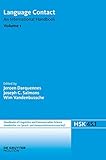Language Contact : An International Handbook. Volume 1 / ed. by Jeroen Darquennes.
Material type: TextSeries: Handbücher zur Sprach- und Kommunikationswissenschaft / Handbooks of Linguistics and Communication Science [HSK] ; 45/1Publisher: Berlin ; Boston : De Gruyter Mouton, [2019]Copyright date: ©2019Description: 1 online resource (XIII, 853 p.)Content type:
TextSeries: Handbücher zur Sprach- und Kommunikationswissenschaft / Handbooks of Linguistics and Communication Science [HSK] ; 45/1Publisher: Berlin ; Boston : De Gruyter Mouton, [2019]Copyright date: ©2019Description: 1 online resource (XIII, 853 p.)Content type: - 9783110441062
- 9783110433258
- 9783110435351
- online - DeGruyter
- Issued also in print.
| Item type | Current library | Call number | URL | Status | Notes | Barcode | |
|---|---|---|---|---|---|---|---|
 eBook
eBook
|
Biblioteca "Angelicum" Pont. Univ. S.Tommaso d'Aquino Nuvola online | online - DeGruyter (Browse shelf(Opens below)) | Online access | Not for loan (Accesso limitato) | Accesso per gli utenti autorizzati / Access for authorized users | (dgr)9783110435351 |
Frontmatter -- Preface -- Contents -- 1. Language contact research: scope, trends, and possible future directions -- I. Linguistic aspects of language contact -- 2. Contact-induced change -- 3. Universal processes in contact-induced syntactic change -- 4. Contact-induced semantic change -- 5. Lexicon and word formation -- 6. Morphology -- 7. Orthography and graphemics -- 8. Levels of representation in phonetic and phonological contact -- 9. Pidginization and creolization -- 10. Varieties in contact -- 11. Language contact and constructed languages -- II. Language contact and the individual -- 12. Pragmatics -- 13. Borrowing -- 14. Code-switching -- 15. Language contact across the lifespan -- 16. Uninstructed language acquisition in multiple language learners -- 17. First language attrition and contact linguistics -- 18. Individual variation in bilingual lexical processing: the impact of second language proficiency and executive function on cross-language activation -- 19. Metalinguistic awareness and multilingual development -- 20. Language attitudes -- 21. Gender and language contact: how gender is/isn’t marked in language contact -- III. Societal aspects of language contact -- 22. Multilingualism -- 23. From geographical and social boundaries to epistemic breaks -- 24. Language and identity in language contact settings -- 25. Language ideology -- 26. Speech community -- 27. Urban and rural language contact -- 28. Globalization and superdiversity 28. Globalization and superdiversity -- 29. States, nations, and language contact -- 30. Language politics, policy, and planning -- 31. Majorities and minorities in language policy and language rights -- 32. Language standardization -- 33. Domains -- 34. Language contact and education: from language separation to translanguaging pedagogy -- 35. Media and contact linguistics -- 36. Language contact in the linguistic landscape -- 37. Language shift -- 38. Language maintenance -- IV. Methodological issues -- 39. Quantitative analysis of language contact data -- 40. Qualitative data elicitation and analysis -- 41. Surveys -- 42. The representativeness of samples -- 43. The geolinguistic treatment of demolinguistic data -- 44. Domain analysis -- 45. Language typology in contemporary perspective -- 46. Social network analysis -- 47. Nexus analysis and multilingualism -- 48. Ethnography in research on language contact -- 49. Interviewing -- 50. Participant Observation -- 51. Discourse analysis -- 52. Corpus linguistic methods -- 53. Psycholinguistic methods in the study of bilingualism -- 54. Research ethics in contact linguistics -- V. Interactions with neighboring disciplines -- 55. Anthropology -- 56. Colonial studies -- 57. Economics and language contact -- 58. Educational sciences -- 59. Language contact and legal studies -- 60. Contact linguistics and literary studies -- 61. Media/Communication studies -- 62. The politics perspective on language contact -- 63. Social psychology -- 64. Translation studies -- Index
restricted access online access with authorization star
http://purl.org/coar/access_right/c_16ec
Language Contact. An International Handbook offers a comprehensive overview of current topics in research on language contact. Broadly conceived, it stands out for its international approach to language contact, complementing the theoretical state-of-the-art with examples from traditionally eclipsed areas and languages. Next to a thorough introductory overview of the ground-breaking methodological and theoretical approaches that shaped the discipline, ample attention goes to the new and innovative insights on language contact in the 21st century. Combining concise introductory contributions with in-depth treatment of the most relevant case studies in the field, the handbook speaks to both junior and established scholars.
Issued also in print.
Mode of access: Internet via World Wide Web.
In English.
Description based on online resource; title from PDF title page (publisher's Web site, viewed 25. Jun 2024)


